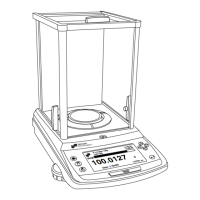Do you have a question about the Denver Instrument P-2002 and is the answer not in the manual?
Essential safety guidelines for operating the balance and handling its components.
Instructions for carefully removing the balance and checking included items.
Guidelines for selecting an optimal location for the balance, considering stability and environment.
Important precautions to follow when handling and assembling the weighing pan.
Step-by-step instructions for attaching the draft shield and placing internal components.
Order of placement for spill ring, sub pan, and weighing pan for toploading balances.
Instructions for placing the weighing pan on toploading balances with square pans.
Procedure for connecting the balance to AC power after it reaches room temperature.
Step-by-step guide to level the balance using the adjustable feet for optimal accuracy.
Detailed steps for taring the balance to zero before weighing.
Steps for performing a simple weighing operation, including placing the sample and waiting for stability.
Reasons why regular calibration is necessary for maintaining accuracy.
Table of recommended calibration weights and classes for different balance models.
Steps for performing external calibration using a calibration weight.
Steps for performing internal calibration on PI Series models.
Procedure to enter the count mode application.
How to set a reference quantity and begin counting pieces.
Steps to place the reference quantity and add uncounted parts for counting.
Steps to enter the target/percent weighing application.
How to perform percent weighing by adding or subtracting parts.
How to enable or disable internal calibration for PI Series models.
Information regarding repairs and the absence of user-serviceable parts.
Detailed instructions for safely cleaning the balance and its components.
Solutions for over capacity and under capacity errors.
Troubleshooting steps for calibration related errors.
| Brand | Denver Instrument |
|---|---|
| Model | P-2002 |
| Category | Accessories |
| Language | English |










